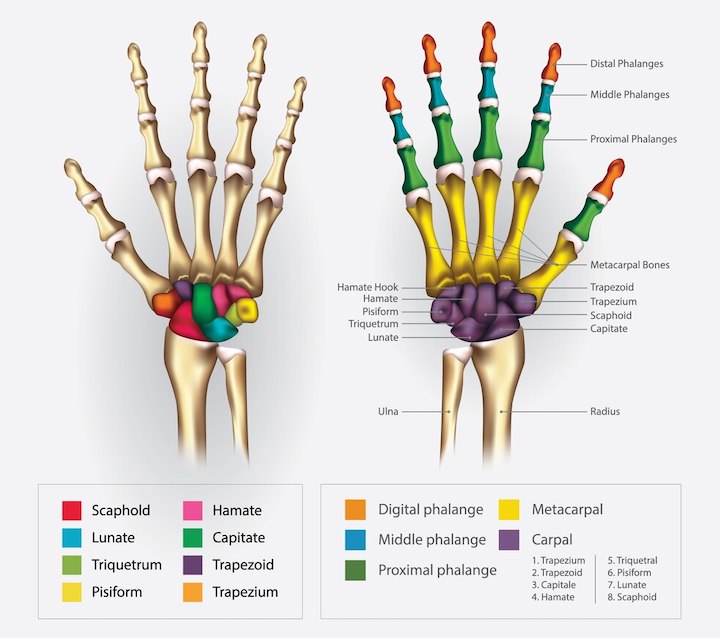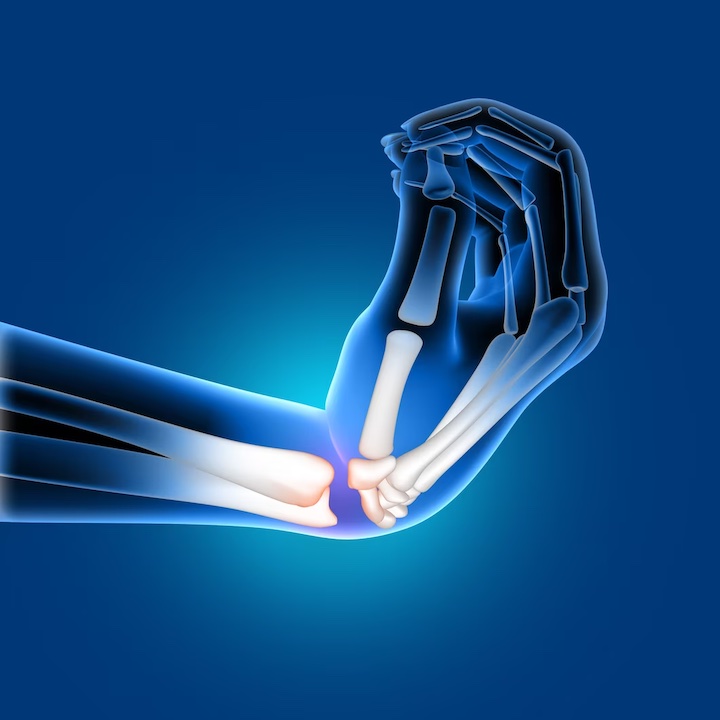Hand and wrist pain can be a common occurrence for many individuals. Various factors, including strains, sprains, fractures, and conditions like carpal tunnel syndrome, can cause this discomfort.
It’s crucial to understand the anatomy of the hand and wrist to identify the sources of pain and prevent further injury properly.
The hand and wrist are intricate structures of various bones, muscles, ligaments, tendons, and nerves. Understanding their anatomy is crucial in diagnosing and treating pain or injuries in these areas.
The wrist consists of eight small carpal bones that connect the forearm to the hand. The carpal bones form three groups: the proximal row, the distal row, and the pisiform bone. The proximal row connects to the radius bone of the forearm, while the distal row connects to the metacarpal bones of the hand.

Photo Credit: PongPongChing, Freepik
The hand comprises five metacarpal bones and 14 phalanges forming the fingers and thumb. The metacarpal bones connect the hand to the wrist, while the phalanges allow for movement and agility.
The wrist is surrounded by various muscles, tendons and ligaments that facilitate movement and stability. The tendons connect the muscles in the forearm to the hand and fingers, while the ligaments attach bones and provide support. Additionally, the nerves in the hand and wrist facilitate sensation and movement.
Each component of the hand and wrist plays a crucial role in its overall function. Damage or injury to any part of the hand or wrist can result in pain, weakness, numbness or a loss of function. As such, understanding the hand and wrist anatomy can help identify the source and extent of the pain or injuries that may occur.
Hand and wrist pain can be caused by a variety of factors, including injuries, overuse, and medical conditions. Here are some common causes:
Strains and sprains are common injuries that can cause pain in the hand and wrist. These injuries occur when the muscles or ligaments in the hand or wrist are stretched or torn. Symptoms of strains and sprains include pain, swelling, and stiffness. Treatment options for these injuries include rest, ice, compression, and elevation.
A fracture is a break in one of the bones in the hand or wrist. Traumatic injuries, such as a fall or a blow to the hand or wrist can cause fractures. Symptoms of a fracture include pain, swelling, and deformity. Treatment options for fractures depend on the severity of the injury and may include immobilisation or surgery.
Carpal tunnel syndrome is a medical condition that occurs when the median nerve, which runs from the forearm to the hand, is compressed as it passes through the carpal tunnel in the wrist. Symptoms of carpal tunnel syndrome include pain, tingling, and numbness in the hand and fingers. Treatment options for this condition may include wrist splints, medication, and surgery.
Repetitive motion, such as typing on a computer or playing a musical instrument, can cause hand and wrist pain over time. This type of pain is often referred to as repetitive strain injury. Symptoms of repetitive strain injury include pain, stiffness, and weakness. Treatment options for this condition may include rest, stretching exercises, and ergonomic modifications to reduce strain on the hand and wrist.
Arthritis is a medical condition that causes inflammation and pain in the joints. Several types of arthritis can affect the hand and wrist, including osteoarthritis and rheumatoid arthritis. Symptoms of arthritis include pain, stiffness, and swelling. Treatment options for arthritis may include medication, physical therapy, and surgery.
If you are experiencing hand or wrist pain, it is important to seek medical attention. A hand and wrist specialist can diagnose the cause of your pain and recommend appropriate treatment options to relieve your symptoms and prevent further injury.
Carpal tunnel syndrome is a common condition that occurs when the median nerve, which runs from the forearm to the hand, becomes compressed or squeezed as it travels through the wrist. This compression can cause pain, numbness, and tingling in the hand and wrist.
Symptoms of carpal tunnel syndrome typically include numbness or tingling in the fingers, particularly the thumb, index, middle, and ring fingers. Pain or aching in the hand or wrist, especially at night, is also common. Additionally, individuals with carpal tunnel syndrome may experience weakness in their hands and difficulty gripping objects.
Treatment options for carpal tunnel syndrome may vary depending on the severity of the condition. Non-surgical treatments such as immobilizing the affected wrist, taking breaks from repetitive activities, and performing hand and wrist exercises may be recommended. Over-the-counter pain relievers or steroid injections may also be used to alleviate symptoms.

Photo Credit: KJPargeter, Freepik
In more severe cases, surgical intervention may be necessary. This may involve releasing the pressure on the median nerve by cutting the ligament that crosses over the carpal tunnel. After surgery, individuals may require physical therapy or rehabilitation to regain full strength and function in their hands and wrist.
While carpal tunnel syndrome cannot always be prevented, there are steps individuals can take to reduce their risk. Maintaining good posture, taking breaks from repetitive activities, and performing hand and wrist exercises can all help prevent carpal tunnel syndrome. Additionally, wearing wrist splints or braces while sleeping or during activities that may aggravate symptoms can also be beneficial.
Hand and wrist exercises can be an effective way to alleviate pain and improve strength and flexibility. Here are some exercises you can try:
Hold your arm out in front of you with your palm facing down. Use your other hand to gently bend your wrist down until you feel a stretch in your forearm. Hold for 15-30 seconds and repeat on the other hand.
Hold your arm out in front of you with your palm facing up. Use your other hand to gently bend your wrist down until you feel a stretch in the back of your forearm. Hold for 15-30 seconds and repeat on the other hand.
Hold your hand out in front of you with your palm facing down. Use your other hand to gently pull your thumb back towards your wrist. Hold for 15-30 seconds and repeat on the other side.
Hold your hand out in front of you with your palm facing down. Use your other hand to gently straighten your fingers, pulling them back towards your wrist. Hold for 15-30 seconds and repeat on the other side.
Squeeze a soft ball or rolled-up towel in your hand as tightly as you can. Hold for 3-5 seconds, then release. Repeat 10-15 times on each hand.
Place your hand flat on a table with your fingers spread apart. Lift each finger one at a time, focusing on keeping the others in contact with the table. Repeat 10-15 times on each hand.
It’s important to remember to perform these exercises slowly and with proper form. Stop immediately and consult a healthcare professional if you experience any pain or discomfort during these exercises. Consistency and proper technique are key for successful hand and wrist pain relief and strengthening.
Occasionally, hand and wrist pain or injuries may require surgical intervention. Surgery may be recommended when non-surgical treatments have not provided relief or when there is a significant loss of function.
Depending on the condition and severity, there are various types of hand and wrist surgeries. Some of the common surgeries include:
It is essential to seek specialised care from a hand and wrist specialist for accurate diagnosis and appropriate treatment plans. These specialists are trained to manage complex hand and wrist conditions and injuries.

Photo Credit: JComp, Freepik
Before undergoing surgery, the specialist will conduct a thorough examination and discuss the available treatment options. They will explain the procedure, risks, and benefits and answer any questions or concerns.
Following surgery, the hand and wrist specialist will provide post-operative care instructions, including rehabilitation exercises and wound care. They will monitor the healing process and adjust the treatment plan as necessary to promote the best possible outcome.
Hand and wrist surgery is a serious medical procedure that should be carefully considered alongside non-surgical options. By seeking specialised care, patients can ensure that they receive an accurate diagnosis, comprehensive treatment plan, and personalised care throughout their recovery.
A: Hand and wrist pain can be caused by various factors, including strains, sprains, fractures, and conditions like carpal tunnel syndrome. Repetitive motions and overuse can also contribute to hand and wrist pain.
A: Carpal tunnel syndrome is characterised by pain, tingling, and numbness in the hand and fingers. Weakness and difficulty gripping objects may also occur.
A: Several exercises can help alleviate hand and wrist pain and improve strength and flexibility. These include wrist curls, finger stretches, and thumb opposition exercises.
A: Hand and wrist surgery may be necessary in cases where conservative treatments have failed to provide relief. It is typically recommended for severe injuries or conditions significantly impacting hand and wrist function.
A: Hand and wrist anatomy is crucial in diagnosing and treating pain and injuries. It helps identify the specific structures involved and guides appropriate treatment approaches.